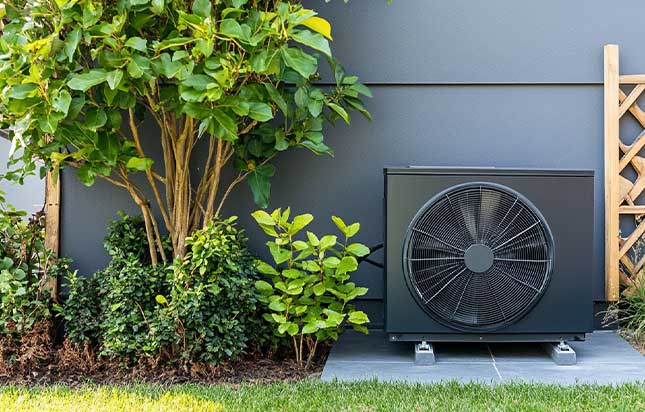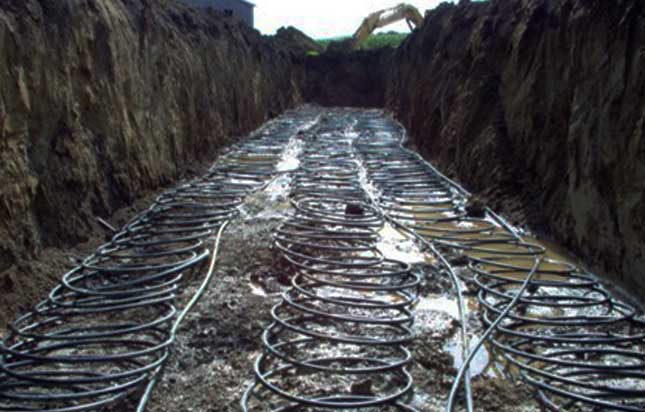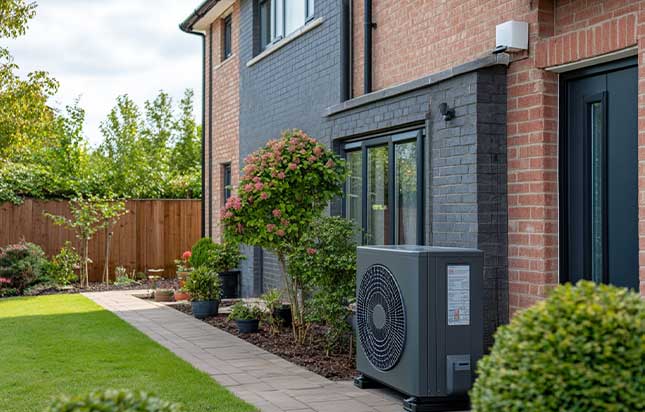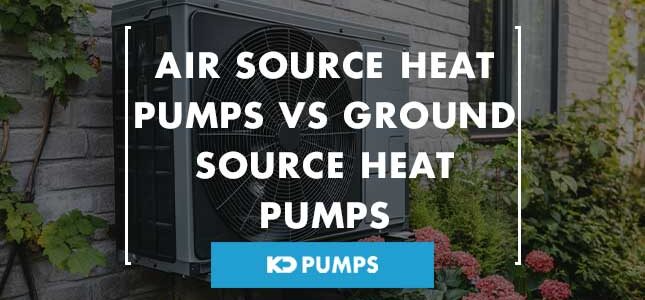Air Source Heat Pumps vs Ground Source Heat Pumps
Heat pumps are becoming popular for heating and cooling homes efficiently and sustainably.
Two common types are air source heat pumps (ASHPs) and ground source heat pumps (GSHPs).
But which is better out of air source heat pumps vs ground source heat pumps?
Both systems offer eco-friendly alternatives to traditional heating methods, but they work in different ways.
This article will explore what each system is, how they work, their benefits and drawbacks, and which might be better for you out of air source heat pumps vs ground source heat pumps.
Article Chapters
Air Source Heat Pumps

What is an Air Source Heat Pump?
An air source heat pump is a system that extracts heat from the air outside to provide heating and cooling for homes or buildings.
Even when the outside air feels cold, the pump can absorb heat and transfer it indoors.
In warmer weather, the system can reverse the process to cool the space, making it versatile for year-round use.
They are commonly used in homes, particularly in areas where connecting to a central heating system is not feasible.
Though less efficient in very cold climates, air source heat pumps can still function effectively in mild to moderately cold environments.
How Does an Air Source Heat Pump Work?
An air source heat pump operates by transferring heat from the outside air into a building to provide heating or cooling.
The system consists of two main components: an outdoor unit and an indoor unit.
Heat Absorption
The process begins when the outdoor unit’s fan pulls outside air through the heat exchanger.
Even in cold weather, the refrigerant inside the heat exchanger absorbs heat from the air.
Compression
The refrigerant, now warmed, flows to the compressor.
The compressor increases the pressure and temperature of the refrigerant, transforming it into a high-energy gas.
Heat Release
This hot gas moves into the indoor unit, where it passes through another heat exchanger.
Here, the refrigerant releases its heat into the indoor air, warming the space.
The refrigerant then cools and condenses back into a liquid state.
Cycle Repeats
The liquid refrigerant returns to the outdoor unit to repeat the process.
In cooling mode, the system reverses this cycle, extracting heat from the indoor air and transferring it outside.
What are the Benefits to an Air Source Heat Pump?
Air source heat pumps offer several benefits, making them a popular choice for heating and cooling homes.
Energy Efficiency
ASHPs are highly efficient in warmer climates, often producing more heat than the energy they consume.
Cost Savings
Because they use less energy than traditional heating systems, ASHPs can lead to lower energy bills.
Over time, homeowners can save significantly on heating and cooling costs.
Versatility
ASHPs provide both heating and cooling, making them suitable for year-round climate control.
This dual functionality eliminates the need for separate heating and cooling systems.
Environmental Benefits
ASHPs rely on renewable energy from the air, resulting in lower carbon emissions compared to fossil fuel systems.
Using an ASHP contributes to reducing your carbon footprint and promoting sustainable living.
Easy Installation
ASHPs are generally easier and faster to install than ground source heat pumps, requiring less extensive ground excavation.
This makes them a more accessible option for many homeowners.
Low Maintenance
ASHPs have fewer moving parts than traditional heating systems, leading to lower maintenance requirements and longer lifespans.
What are the Drawbacks to an Air Source Heat Pump?
While air source heat pumps offer many benefits, they also have some drawbacks to consider.
Reduced Efficiency in Cold Weather
ASHPs can lose efficiency in extremely cold temperatures.
When outside air is very chilly, the system has to work harder to extract heat, which can increase energy consumption and costs.
Backup Heating Needs
In colder climates, ASHPs may require a supplemental heating source, such as electric resistance heating, to maintain comfortable indoor temperatures.
This can further increase energy bills during winter months.
Noise
The outdoor unit of an ASHP can produce noise during operation, which may be bothersome, particularly in quiet neighbourhoods.
This noise can be a concern for some homeowners.
Space Requirements
ASHPs need sufficient outdoor space for the unit and proper airflow.
Homes with limited outside space may find it challenging to install an ASHP.
Initial Cost
Although ASHPs can lead to savings over time, the upfront installation cost can be significant.
This initial investment may deter some homeowners from considering an ASHP.
Aesthetic Concerns
The outdoor unit may not blend well with the home’s exterior, and some homeowners might find it visually unappealing.
Ground Source Heat Pumps

What is a Ground Source Heat Pump?
A ground source heat pump, also known as a geothermal heat pump, is a system that utilises the earth’s stable underground temperature to provide heating and cooling for homes or buildings.
Unlike air source heat pumps, which extract heat from the air, GSHPs rely on the constant temperature of the ground, which remains relatively stable throughout the year.
GSHPs are highly efficient and environmentally friendly, making them a sustainable option for heating and cooling residential and commercial properties.
How Does a Ground Source Heat Pump Work?
A ground source heat pump works by harnessing the stable temperature of the earth to provide heating and cooling for buildings.
The system consists of two main components: the ground loop and the heat pump unit.
Ground Loop
The ground loop is a series of pipes buried underground, typically horizontally or vertically.
This loop is filled with a fluid, often water or a refrigerant, that circulates through the pipes.
Heating Mode
In winter, the GSHP extracts heat from the ground.
The fluid in the ground loop absorbs heat from the earth, which stays at a relatively constant temperature.
This warmed fluid returns to the heat pump, where it passes through a compressor.
The compressor increases the pressure and temperature of the fluid, converting it into a hot gas.
Heat Distribution
The hot gas moves to the indoor unit, where it releases heat into the building through a heat exchanger.
The cooled fluid then returns to the ground loop to absorb more heat.
Cooling Mode
In summer, the process is reversed.
The GSHP removes heat from the indoor air and transfers it back into the ground, effectively cooling the building.
What are the Benefits to a Ground Source Heat Pump?
Ground source heat pumps (GSHPs) offer several significant benefits, making them an attractive choice for heating and cooling homes and buildings.
High Efficiency
GSHPs are highly efficient, often achieving a coefficient of performance (COP) of 3 to 4.
This means they can provide three to four units of heat for every unit of electricity consumed, resulting in lower energy bills.
Consistent Performance
Unlike air source heat pumps, GSHPs are not affected by fluctuating outside temperatures.
The ground maintains a stable temperature year-round, ensuring reliable heating and cooling, even in extreme weather.
Environmental Benefits
GSHPs use renewable energy from the ground, resulting in lower carbon emissions compared to traditional heating systems.
This makes them an eco-friendly option that contributes to reducing your carbon footprint.
Long Lifespan
The components of a GSHP, particularly the underground ground loop, can last over 50 years with proper maintenance.
The indoor unit typically lasts 20 to 25 years, making GSHPs a durable investment.
Low Maintenance Requirements
GSHPs require less maintenance than conventional heating systems, as most components are buried underground and protected from the elements.
This leads to fewer repairs and lower long-term costs.
What are the Drawbacks to a Ground Source Heat Pump?
While ground source heat pumps offer many benefits, they also have some drawbacks that potential users should consider.
High Installation Costs
The initial cost of installing a GSHP can be significant.
Excavation or drilling for the ground loop requires a substantial investment, which may not be feasible for all homeowners.
Space Requirements
GSHPs require adequate outdoor space for the ground loop.
If a property has limited outdoor space, especially for horizontal loops, the installation may be challenging.
Vertical loops are an option but come with higher drilling costs.
Complex Installation
Installing a GSHP is more complex than installing air source heat pumps.
It requires specialised knowledge and equipment to ensure proper installation and performance, potentially limiting the availability of qualified contractors.
Long Payback Period
While GSHPs can lead to lower energy bills, it may take several years to recoup the initial investment.
The long payback period can deter some homeowners from choosing this option.
Soil Conditions
The effectiveness of a GSHP depends on the soil type and geological conditions.
Certain soil types may not conduct heat well, which can impact system efficiency and performance.
Air Source Heat Pumps vs Ground Source Heat Pumps: Which is Better?

When considering heating and cooling options, many homeowners ponder the choice between air source heat pumps vs ground source heat pumps.
Each system has its unique advantages and potential drawbacks, making the decision dependent on various factors.
Cost
ASHPs typically have a lower initial installation cost compared to GSHPs.
The installation process for ASHPs is generally simpler and faster, as it requires less excavation and fewer materials.
In contrast, GSHPs involve digging or drilling to install the ground loop, which can be expensive and labour-intensive.
However, GSHPs often lead to lower operating costs over time due to their higher efficiency.
Efficiency
GSHPs are generally more efficient than ASHPs.
They can provide a consistent heat source regardless of outside temperatures, as the ground maintains a stable temperature year-round.
This makes GSHPs especially effective in regions with extreme weather.
ASHPs can struggle in very cold conditions, as their efficiency decreases when the outside air temperature drops.
Space Requirements
ASHPs require less outdoor space than GSHPs, making them suitable for homes with limited outdoor space.
Conversely, GSHPs need adequate land for the ground loop, which can limit installation options, especially in urban areas.
Environmental Impact
Both systems offer significant environmental benefits compared to traditional heating methods.
However, GSHPs typically have a smaller carbon footprint due to their higher efficiency and use of stable ground temperatures.
Conclusion
You should now have more of an understanding of air source heat pumps vs ground source heat pumps
Choosing between an air source heat pump and a ground source heat pump depends on several factors, including cost, efficiency, climate, and space availability.
Air source heat pumps are more affordable and easier to install, making them a great option for homes with limited outdoor space or in milder climates.
They provide both heating and cooling, but may be less efficient in colder weather.
Ground source heat pumps are more efficient, particularly in extreme climates, and offer long-term savings on energy bills.
However, they are expensive to install and require a large area for the ground loop.
In the end, the best option depends on your individual circumstances, budget, and long-term energy goals.
Both systems are eco-friendly and provide sustainable solutions for heating and cooling your home.
For more information, please get in contact with us here at KD Pumps.


Comments are closed.